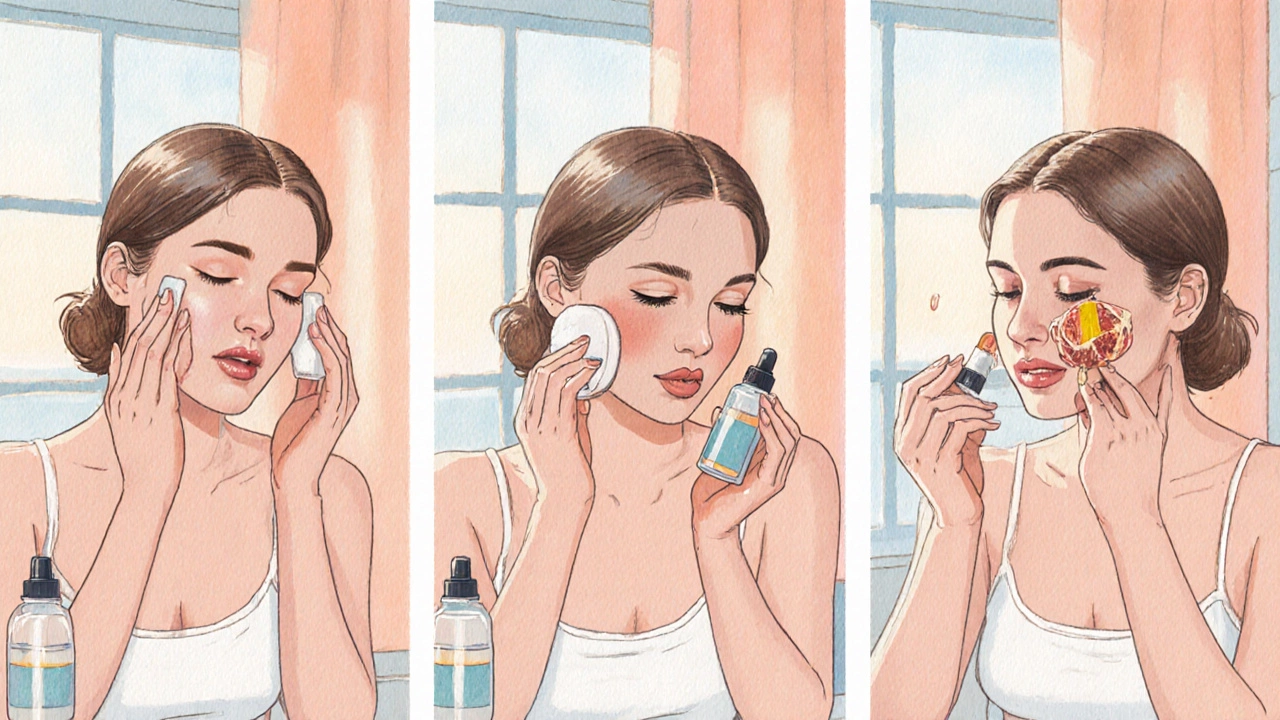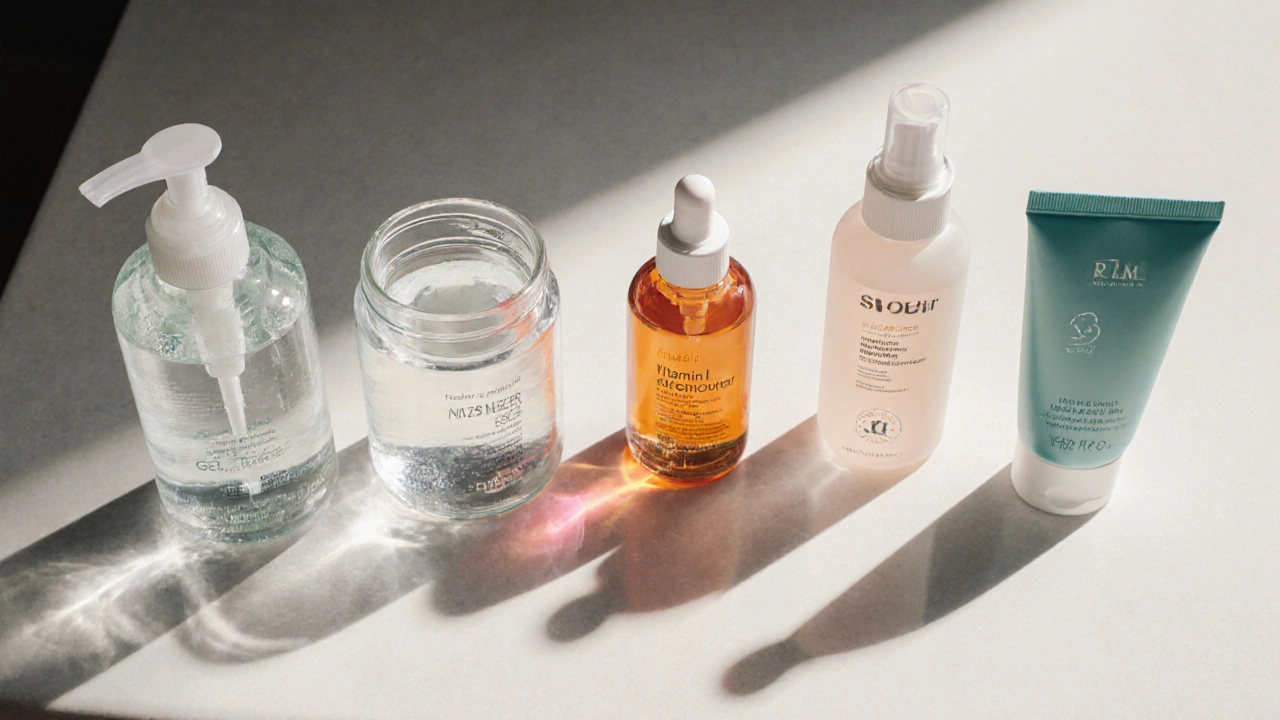Skincare Routine Order Checker
Your Routine
Result
Select products and click 'Check My Order' to see if your routine is correct.
Why Order Matters
Applying products from thinnest to thickest texture maximizes absorption. Incorrect order can trap actives under barriers or cause irritation.
Never apply sunscreen before moisturizer. Sunscreen must be the final step for effective UV protection.
When you hear skincare routine order is the sequence in which you apply your skin‑care products to maximise absorption and results, you might wonder if there’s a universal rule. The truth is there are core steps that work for most skin types, and a few tweaks for specific concerns. Below you’ll find a clear roadmap that works for both beginners and seasoned skin‑care fans.
Why the Order Matters
Each product has a different texture, pH, and purpose. Applying a heavy cream before a light serum can trap the serum under a barrier, wasting its actives. Conversely, layering a low‑pH toner after a high‑pH cleanser helps balance the skin’s surface, prepping it for the next step. Understanding the science behind the order lets you get the most out of every bottle.
Morning Routine: The Basics
-
Cleanser is a gentle wash that removes overnight sweat, sebum and any leftover product residue. Choose something that rinses clean without stripping your skin’s natural oils. A gel or cream cleanser works for most types.
-
Toner is a watery formula that restores pH and adds a light layer of hydration. Look for ingredients like rose water or witch hazel if you’re oily, or hyaluronic acid for dry skin.
-
Serum is a concentrated treatment that targets specific concerns such as brightening, anti‑aging or acne. Vitamin C serums are popular in the AM because they protect against free‑radical damage from UV light.
-
Moisturizer is a barrier‑forming cream or lotion that locks in the previous layers. Pick a lightweight, non‑comedogenic formula for daytime use.
-
Sunscreen is the non‑negotiable final step that protects skin from UV‑A and UV‑B rays. Even on cloudy days, aim for at least SPF 30 and reapply every two hours if you’re outdoors.
That’s the core skincare routine order for mornings. You can add an eye cream after the moisturizer if you need extra hydration around the delicate eye area.
Night Routine: Repair Mode
-
Start again with a Cleanser to wipe away makeup, sunscreen and pollution. Double‑cleansing (oil‑based first, water‑based second) is a great option for heavy makeup users.
-
If you like a Toner, keep using it. Some prefer a slightly richer, hydrating toner in the evening.
-
Apply a treatment‑focused serum. Retinoids, peptide blends or niacinamide work well at night because they don’t need sunlight to activate.
-
Follow with a richer Moisturizer or a sleeping mask. Ingredients like ceramides and squalane seal in the actives while you sleep.
-
Optional: add an Exfoliant is a chemical (AHA/BHA) or gentle physical scrub used 1‑3 times a week to clear dead cells. Do this before the serum on the nights you exfoliate.
If you’re prone to dark circles, a targeted Eye cream after the moisturizer can help with hydration and brightening.

Special Steps & When to Use Them
- Exfoliation: Reserve for 1‑3 times per week depending on skin tolerance. Over‑exfoliating can compromise the skin barrier.
- Mask nights: Clay masks for oily skin, hydrating masks for dry skin. Apply after cleansing and before serum.
- Spot treatments: Use benzoyl peroxide or salicylic acid directly on blemishes after the serum but before moisturizer.
Customising for Different Skin Types
Oily / Acne‑prone: Choose a foaming Cleanser with salicylic acid, a lightweight Moisturizer that’s oil‑free, and a mattifying sunscreen.
Dry / Sensitive: Opt for a cream Cleanser, a hydrating toner with glycerin, a serum rich in hyaluronic acid, and a barrier‑repair moisturizer with ceramides.
Combination: Mix and match - use a gentle cleanser, a balancing toner, a serum that targets specific zones, and a moisturizer that can be layered (lighter gel in T‑zone, richer cream on cheeks).
Common Mistakes to Avoid
- Skipping sunscreen because you stay indoors - UV rays still penetrate windows.
- Applying products from thickest to thinnest - the reverse blocks absorption.
- Mixing actives that can irritate each other, like Vitamin C with retinoids, in the same application.
- Using the same routine year‑round - change to heavier products in winter and lighter ones in summer.
Quick Checklist - Your Daily Order at a Glance
| Step | Morning | Night |
|---|---|---|
| 1. Cleanse | Gentle gel/cream | Double cleanse if wearing makeup |
| 2. Tone | Balancing, hydrating | Hydrating or soothing |
| 3. Treat | Vitamin C serum | Retinoid or peptide serum |
| 4. Moisturize | Lightweight, SPF‑compatible | Richer night cream or mask |
| 5. Protect | Sunscreen (SPF 30+) | Optional eye cream |
Putting It All Together: A Sample Day
Imagine you’re getting ready for work. You splash lukewarm water, massage a pea‑sized amount of gel Cleanser onto your damp face, rinse, and pat dry. You swipe a cotton pad saturated with a hydrating Toner, then tap a few drops of Vitamin C Serum into your skin. A dollop of oil‑free Moisturizer follows, and you finish with a broad‑spectrum SPF 50 Sunscreen. At night, after a second cleanse, you apply a niacinamide serum, a richer ceramide‑rich night cream, and a soothing eye cream. The sequence feels effortless because each product is built to complement the previous one.
Next Steps & Troubleshooting
If you notice irritation after a new product, backtrack one step and see if the issue resolves. Stubborn breakouts often mean a product is too heavy for your skin type, so switch to a lighter Moisturizer. If you’re not seeing results after four weeks, consider adding a weekly Exfoliant or swapping in a more potent active.
Can I skip the toner?
Yes, if your cleanser already leaves your skin balanced and hydrated. Toner is optional but helps fine‑tune pH and adds an extra layer of moisture, which can be useful for dry or acne‑prone skin.
Should I apply sunscreen before or after moisturizer?
Apply sunscreen as the last step. Moisturizer can help seal in actives, but sunscreen needs to sit directly on the skin to form an even protective film.
How often should I use a retinoid?
Start with 2‑3 times a week at night and monitor how your skin reacts. Once tolerated, you can increase to nightly use, always following with a gentle moisturizer.
Is double cleansing necessary for everyone?
If you wear sunscreen or makeup daily, double cleansing helps remove all residues. Those who only use light products can stick with a single, thorough cleanse.
Can I use Vitamin C and niacinamide together?
Modern formulations are stable enough to layer them. Apply Vitamin C first (lower pH) and let it absorb, then follow with niacinamide. Watch for any irritation if your skin is very sensitive.

